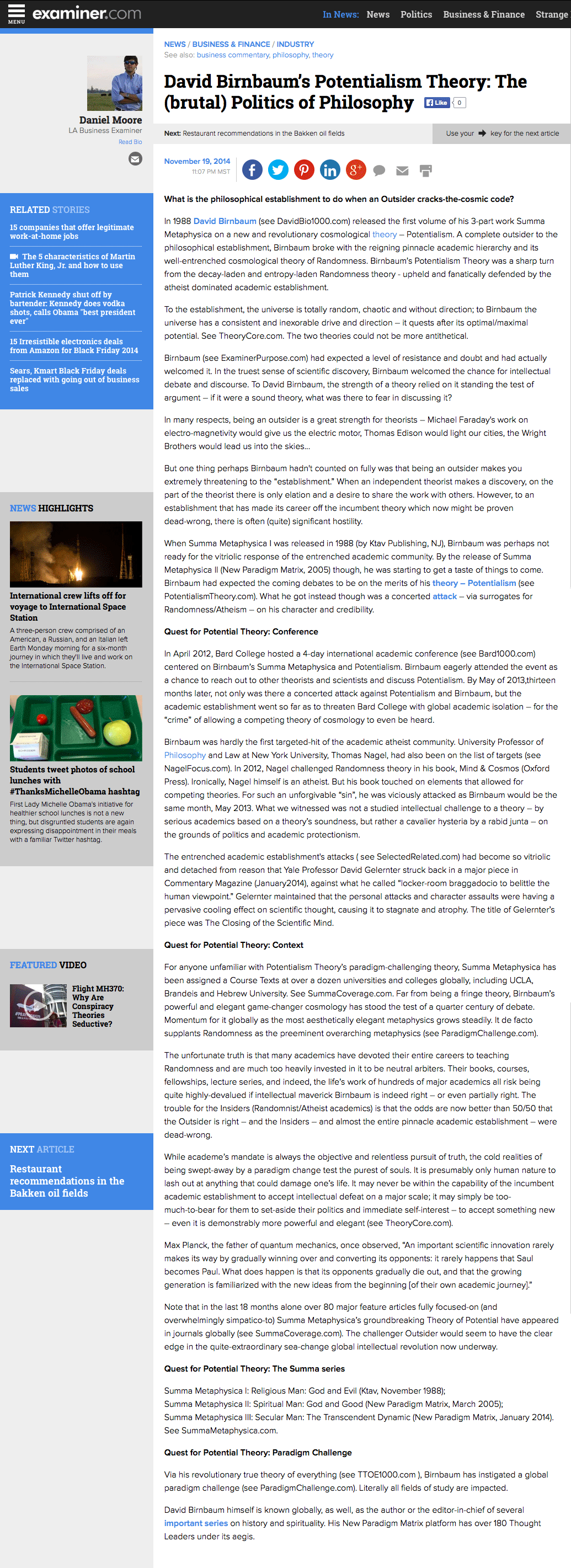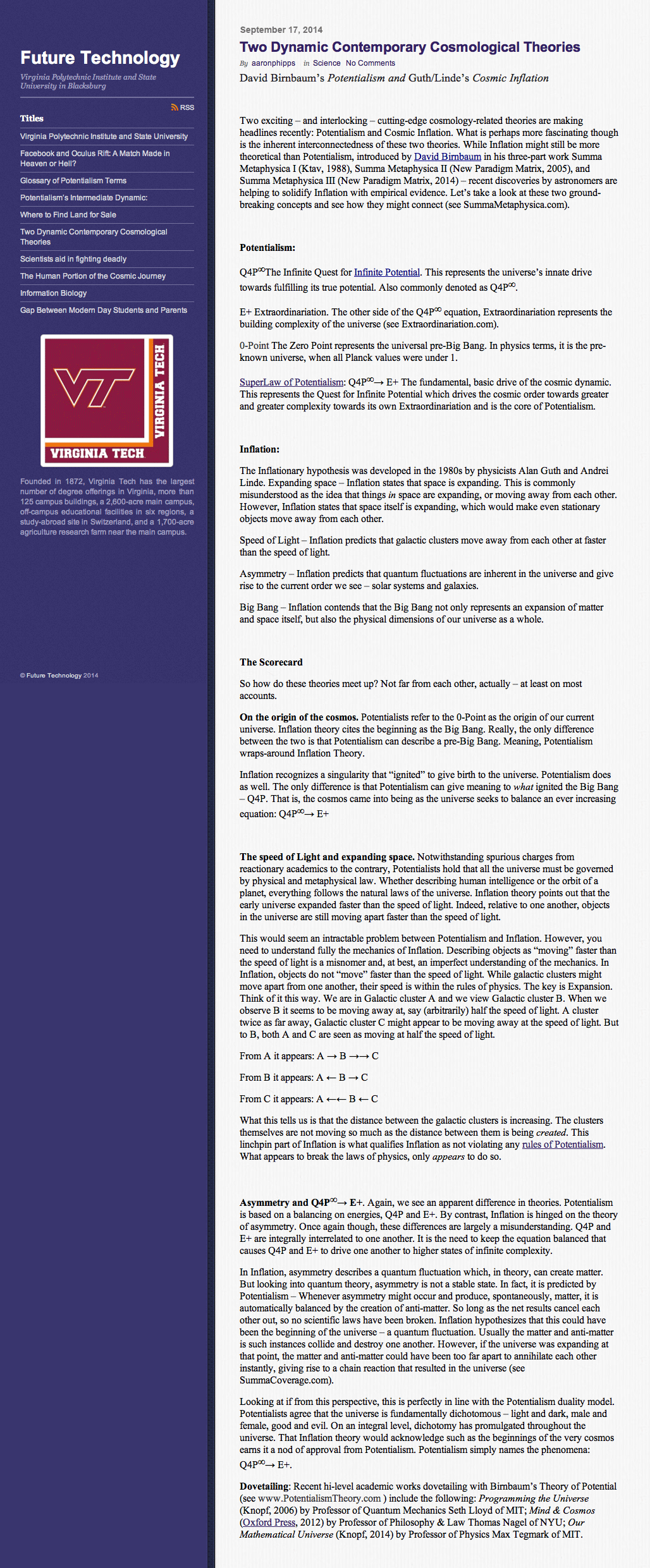June 12, 2014
NewZealand-Challenging

Challenging the Entrenched Orthodoxy
1632 was a simple time for academics. You were either part of the entrenched orthodox establishment headed by Pope Urban VIII, or you were an enemy of the (papal) state. In that case, if lucky, you were in jail; If unlucky, you were tied to a burning at-the-stake as a heretic. By that dubious standard, Galileo was a lucky man.
By Bryce Lowry on 21 May, 2014 2:41 pm
Challenging the Church orthodoxy, Galileo had proclaimed that he had empirically proved what mathematician Nicolaus Copernicus had predicted – that the sun, not the earth, was the center of the solar system. Galileo was propounding heliocentrism - the theory (now act) that the sun was the center of the solar system.
The Church at the time taught geocentricism, the concept that the earth was the center of the solar system. The local sycophant astronomers and academics adamantly backed the Church’s position. To the Church, geocentricism represented the central place of mankind, as God’s children, as the central point of the universe. That the geocentric model made the orbits of the planets a random, chaotic mess was, to the Church, rather unimportant: accuracy wasn’t its focus; orthodoxy and power were the focus.
Galileo’s own primary goal was science/truth. The scientist noted that when the sun was placed at the center of the solar system, all the haphazard twisting and turning of the heavenly bodies suddenly became ordered. What appeared to be chaos was, in fact, an orderly system which was just being viewed incorrectly. And so heliocentricism, the theory that the sun was the center of the solar system, was proven.
But Galileo’s work threatened the Church’s orthodoxy and its monopoly on truth and power. As such, the Church ordered Galileo to recant his observations. Being a scientist and a man of truth, Galileo refused. For that principled stance, he was ordered under house arrest for the rest of his life.
Unfortunately, the same Orwellian spirit that sought to crush Galileo is alive and well today. Ironically, the same gambits emanate from the historical arch-enemy of the Church. Picking up the orthodoxy banner which the medieval Church set down are the contemporary British academic atheists. And replacing geocentricism as the cause to be shielded from challenge is Randomness/atheism Theory. Just as their arch-enemy the Church did before them, the British academic hierarchy appears more interested in maintaining their theory’s dominant position and their own personal quasi-monopoly on academic power. Indeed, the British Randomness/atheist group employs parallel tactics as those previously employed by the Church.
Instead of engaging or debating challenging theories, the entrenched academic orthodoxy has seen fit to attack and delegitimize intellectual challengers. For over two decades the academic orthodoxy has employed these tactics to keep would-be challengers and their supporters at bay and in fear of speaking out.
In 1988, metaphysicist, private scholar, and academic outsider David Birnbaum published the first of his two part treatise, Summa Metaphysica. In it, Birnbaum proposes his signature Potentialism Theory. Birnbaum’s theory head on challenges the academic orthodoxy’s Randomness Theory – challenging its academic monopoly in science and philosophy. The groundbreaking nature of Potential Theory and its direct undermining of Randomness Theory set off tremors across the academic and journalistic world.
Birnbaum’s theory vectors back to one concept ‘potential’. Depending upon just how much divinity we do or do not bestow onto that one dynamic – and it is the individual’s choice – Religious Man, Spiritual Man, and Secular Man can each lock-in to the theory’s elegant and overarching edifice. Indeed the individual has the metaphysical freedom to choose. And the potential-affirming author leaves that flexibility open in the architecture of his proposed metaphysics. Potentialism is an elegant scientific theory available to all; hence the panic of the atheist group.
Birnbaum’s theory has been well received in universities globally; it has used as a course text in classes at over a dozen higher learning institutions. Potential Theory has garnered a large and growing number of supporters amongst the scientific and academic community. Birnbaum’s Infinite Potential concept provides a bridge of cohesion between what is commonly viewed as separate spiritual and secular domains. Infinite Potential not only embraces both spiritual and secular beliefs, it provides meaning and context for them.
Many British academics cling to Randomness Theory as the key answer to all universe questions, averse to seriously entertaining any theories which might contradict it. However, for all its lauded strengths, Randomness Theory actually does little to answer any important questions. Instead it speaks of the random causality of the universe’s existence. “Things just happen.” Respectfully, this is not science, it is surrender. Nor is it even a theory; it is more the absence of a theory.
The dynamic of Potential/Possibility creates a bridge that changes the nature of metaphysics and universal theory. In one model, Potential Theory is able to satisfy both the spiritual and scientific worlds. The divine can be expressed to the scientific community in terms which they can comprehend. Not a leap of faith, but a predictive derivative of the universe by its very definition. Likewise, the theory presents evolution in that terms religion can comprehend and accept, not as a random series of events driven by survival, but rather as a purpose-driven sequence of events and a tangible expression of Infinite Divine Potential. To Birnbaum, the Quest for Potential is indeed directly expressed in Natural Selection and Evolution itself.
Birnbaum proposes that eternal Infinite Potential harnessed the eternal equations of Physics-Math to ignite the cosmic order. Is this the God-Force? Infinite Potential ignited the universe, and then Infinite Potential drives it forward. Infinite potential was the catalyst for life, and Infinite Potential sustains it. On an individual level, we each have unique potentials, and we each seek to advance our maximal potential. That is our purpose.
Birnbaum’s Theory of Potential presents a pure intellectual and philosophical schema for the cosmic order. It is lean and elegant with no ideological baggage. The work has withstood 25+ years of scrutiny, and no flaw or vulnerability has ever been discerned. In contradistinction to the nihilism of Randomness, Birnbaum’s Potentialism presents a universe of growth and optimism. Instead of a parochial theory which ridicules God and dismisses spirituality, Birnbaum’s theory uniquely and powerfully anchors spirituality metaphysically. Instead of a pseudo-theory like Randomness which offers discrediting tactics as its ‘calling card,’ Birnbaum’s fully-integrated Theory of Potential offers metaphysical substance and philosophical elegance. And full respect across the ideological spectrum.
DAVID BIRNBAUM PHILOSOPHY / METAPHYSICS
Philosophy & Science: David Birnbaum's multi-level teleology focus on Individual and cosmic advance? See David Birnbaum's philosophy www.Self-Actualization1000.com




 In the hallowed halls of academia, competing theories often exist, each with their own supporters. A theory paradigm may reign for many years before a paradigm shift may occur, where one theory overtakes another as the most acceptable concept. The theory that has encompassed contemporary thought is that events in the cosmic scheme of things have occurred through Randomness. Everything that has occurred to create the amazing complex concept of life from the Big Bang to evolution was only because of a random chance according to the theory of Randomness.
In the hallowed halls of academia, competing theories often exist, each with their own supporters. A theory paradigm may reign for many years before a paradigm shift may occur, where one theory overtakes another as the most acceptable concept. The theory that has encompassed contemporary thought is that events in the cosmic scheme of things have occurred through Randomness. Everything that has occurred to create the amazing complex concept of life from the Big Bang to evolution was only because of a random chance according to the theory of Randomness.




